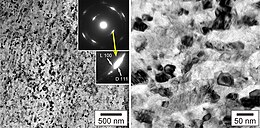Aggregated diamond nanorod



Aggregated diamond nanorods, or ADNRs, are a
Discovery
Nanodiamond or hyperdiamond was produced by compression of
Hardness
A
Synthesis
ADNRs (hyperdiamonds/nanodiamonds) are produced by compressing fullerite powder—a solid form of allotropic carbon fullerene—by either of two somewhat similar methods. One uses a diamond anvil cell and applied pressure ~37 GPa without heating the cell.[6] In another method, fullerite is compressed to lower pressures (2–20 GPa) and then heated to a temperature in the range of 300 to 2,500 K (27 to 2,227 °C).[7][8][9][10] Extreme hardness of what now appears likely to have been nanodiamonds was reported by researchers in the 1990s.[5][6] The material is a series of interconnected diamond nanorods, with diameters of between 5 and 20 nanometres and lengths of around 1 micrometre each.[citation needed]
Nanodiamond aggregates ca. 1 mm in size also form in nature, from graphite upon meteoritic impact, such as that of the Popigai impact structure in Siberia, Russia.[1]
See also
- Adamant – Mythological hardest substance
- Carbon nanotube – Allotropes of carbon with a cylindrical nanostructure
- Diamond – Form of carbon
- Fullerite– Allotrope of carbon
- Lonsdaleite – Hexagonal lattice allotrope of carbon
- Mohs scale of mineral hardness– Qualitative scale characterizing scratch resistance
- Rhenium diboride – chemical compound
- Superhard material – Material with Vickers hardness exceeding 40 gigapascals
References
- ^ PMID 26424384.
- S2CID 52856300.
- .
- PMID 16608291.
- ^ doi:10.1016/S0925-9635(97)00232-X. Archived from the original(PDF) on 2011-07-21.
- ^ .
- .
- .
- .
- .
External links
- The invention of aggregated diamond nanorods at Physorg.com
- Jeandron, Michelle (August 26, 2005). "Diamonds are not forever". Physics World. Archived from the original on March 4, 2009. Retrieved August 7, 2009.
